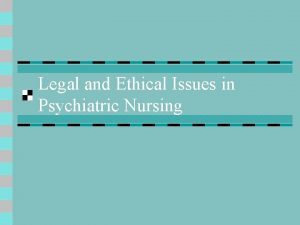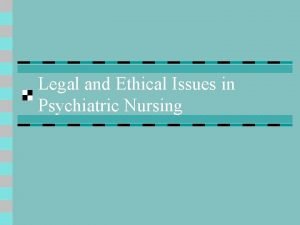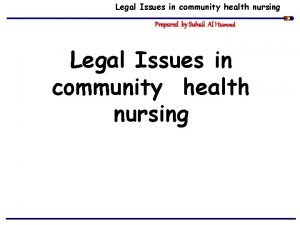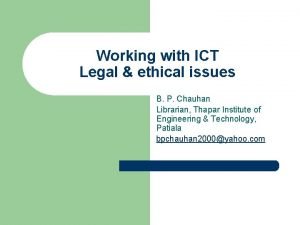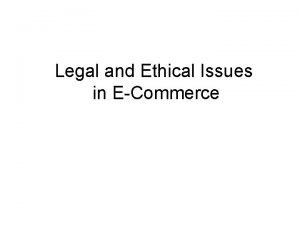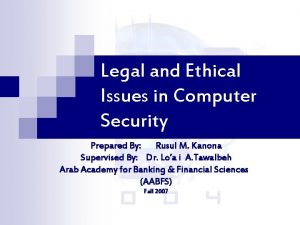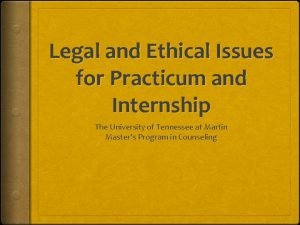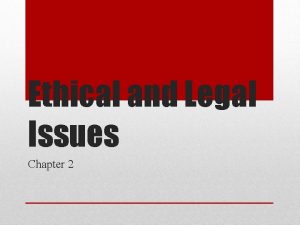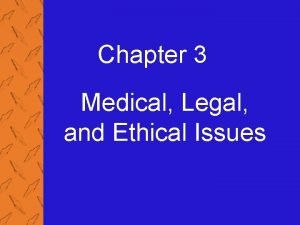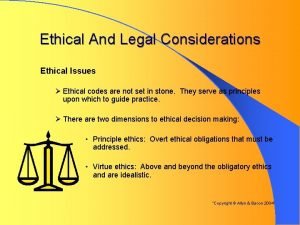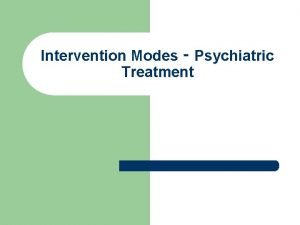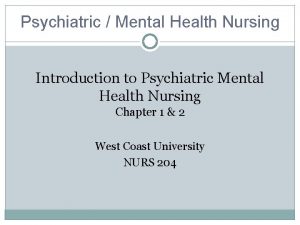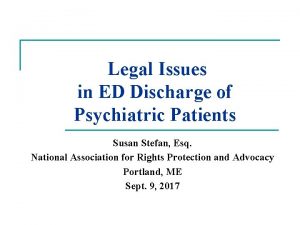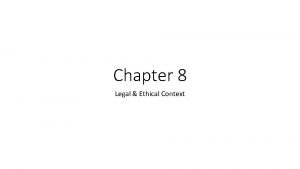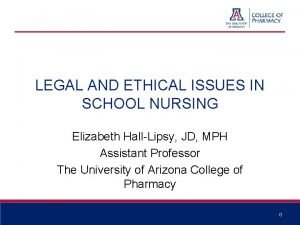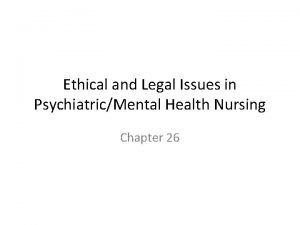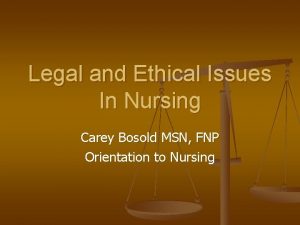Legal and Ethical Issues in Psychiatric Nursing Patients














- Slides: 14

Legal and Ethical Issues in Psychiatric Nursing

Patient’s Bill of Rights Civil Rights n Client Consent n Communication n Freedom from Harm n Dignity and Respect n Confidentiality n Participation in Their Treatment Plan n

Admission to the Hospital Voluntary n Involuntary n

Client’s Rights Under the Law Right to Treatment n Right to Refuse Treatment n Right to Informed Consent n Rights Regarding Restraint and Seclusion n

Right to Treatment Clients have the right to receive treatment for psychiatric problems n Rx must meet the following criteria: n The environment must be humane n Staff must be qualified and sufficient to provide adequate Rx n The plan of care must be individualized n

Right to Refuse Treatment n n When forcible medication is used to prevent violence to third parties, to prevent suicide, or to preserve security, the court noted that the med is being used as a chemical restraint—changes from individual rx to public protection If it is deemed that an individual is unable to make a competent, informed, and voluntary decision re: rx, courts have stated that the med determinations and rx plans are best left to the professionals

Rights Regarding Seclusion and Restraint n Legally, behavioral restraint and seclusion are authorized as an intervention when: n n n The particular behavior is physically harmful to the client or a 3 rd party The disruptive behavior presents a danger to the facility Alternative or less restrictive measures are insufficient in protecting the client and others from harm When a decrease in sensory over stimulation (seclusion only) is needed When a client requests seclusion

Rights Regarding Seclusion and Restraint (cont) n n The use of seclusion and restraint is permitted only: On the written order of a physician n n n Must be face-to-face exam by MD within 1 hr of the application Next 4 hrs can have phone order Next 4 hrs need to have face-to-face exam…etc Clients should be assessed q 15 min Restraints must be rotated q 2 h Food and fluids should be offered at least q 2 h

Rights Regarding Seclusion and Restraint (cont) n Documentation— Should reflect that lesser restrictive methods were tried n The behavior leading to restraint/seclusion n

Tort Law n n n Torts are civil wrongs for which money damages are collected by the injured party (plaintiff) from the wrongdoer (defendant) Civil liability for nsg practice falls in the area of tort law 3 types of torts: n n n Intentional Quasi-intentional Unintentional

Intentional n Assault n n Battery n n An act resulting in a person’s apprehension of an immediate harmful or offensive touching (battery) Harmful or offensive touching False imprisonment n n An act with intent to confine a person to a specific area The use of seclusion or restraint that is not defensible as being necessary or in the pt’s best interest

Quasi-Intentional n Defamation is made up of 2 torts: Slander or oral communication n Libel or written communication n n Breach of confidentiality

Unintentional n Professional negligence n n Involves harm resulting from the failure of a person to conduct himself or herself in a reasonable and prudent manner 4 items needed to prove negligence are: n n Duty—measured by standard of care Breach of duty—conduct that exposes the client to an unreasonable risk of harm Proximate cause—Intervening actions or persons that were, in fact, the causes of harm to the client Damages—pain and suffering

Duty to Warn Third Parties Tarasoff case of 1976 n A duty to warn third parties exists when a therapist determines that the pt presents a serious physical danger to another person n
 Ethical and legal issues in psychiatric nursing
Ethical and legal issues in psychiatric nursing Ethical issues in psychiatric nursing
Ethical issues in psychiatric nursing Ethical and legal issues affecting the nursing assistant
Ethical and legal issues affecting the nursing assistant Legal aspects of community health
Legal aspects of community health Ethical issues in treating lgbt patients
Ethical issues in treating lgbt patients Conclusion of nursing process
Conclusion of nursing process Nursing process in psychiatric nursing
Nursing process in psychiatric nursing Legal ethical and societal issues in media and information
Legal ethical and societal issues in media and information State legal, ethical and professional aspects of security.
State legal, ethical and professional aspects of security. Legal and ethical issues in use of ict in education
Legal and ethical issues in use of ict in education What is ethical issues in e commerce
What is ethical issues in e commerce Legal and ethical issues in computer security
Legal and ethical issues in computer security Professional and ethical issues during internship
Professional and ethical issues during internship Ethical and legal issues chapter 2
Ethical and legal issues chapter 2 Chapter 3 medical legal and ethical issues
Chapter 3 medical legal and ethical issues
